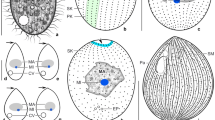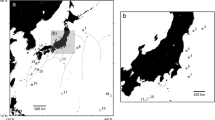Abstract
A parasitic water mold (oomycete) of unknown origin was discovered infecting live native and exotic freshwater gammarid amphipods (Gammarus fasciatus and Echinogammarus ischnus, respectively) in the upper St. Lawrence River. Infections were associated with rapid die-offs of natural populations of amphipods, especially the exotic E. ischnus. Analysis of sequences of three different segments of the rRNA gene cluster indicated that the parasite was in the Saprolegniaceae family, and is related to other crustacean-associated Saprolegniaceae. Specific primers were designed based on the SSU rRNA gene and utilized for semi-quantitative analysis of parasite presence in live and dead amphipods. In laboratory experiments, infection prevalence was higher in E. ischnus individuals than in native amphipods. In addition, dead E. ischnus individuals exhibited more intense infections than G. fasciatus individuals. In contrast to the Great Lakes where E. ischnus has replaced G. fasciatus at many locations, the native species remains abundant in the St. Lawrence River more than a decade after invasion by E. ischnus in the late 1990s. We hypothesize that the parasite is facilitating the co-existence of the two amphipod species by reducing the abundance of E. ischnus in environments in which it might otherwise be dominant.




Similar content being viewed by others
References
Altschul SF, Gish W, Miller W, Myers EW, Lipman DJ (1990) Basic local alignment search tool. J Mol Biol 215:403–410
Barron GL (2004) Fungal parasites and predators of rotifers, nematodes, and other invertebrates. In: Mueller GM, Bills GF, Foster MS (eds) Biodiversity of fungi. Elsevier, Amsterdam, pp 435–450
Bly JE, Lawson LA, Szalai AJ, Clem LW (1993) Environmental factors affecting outbreaks of winter saprolegniosis in channel catfish, Ictalurus punctatus (Rafinesque). J Fish Dis 16:541–549
Boisclair D, Leggett WC (1989) Among-population variability of fish growth: II. Influence of prey type. Can J Fish Aquat Sci 46:468–482
Cerenius L, Söderhäll K, Persson M, Ajaxon R (1988) The crayfish plague fungus, Aphanomyces astaci—diagnosis, isolation, and pathobiology. Freshw Crayfish 7:131–144
deRivera CE, Ruiz GM, Hines AH, Jivoff P (2005) Biotic resistance to invasion: native predator limits abundance and distribution of an introduced crab. Ecology 86:3364–3376
Dermott R, Witt J, Um EM, Gonzalez M (1998) Distribution of the Ponto-Caspian amphipod Echinogammarus ischnus in the Great Lakes and replacement of native Gammarus fasciatus. J Great Lakes Res 24:442–452
Dick MW, Vick MC, Gibbings JG, Hedderson TA, Lastra CCL (1999) 18S rDNA for species of Leptolegnia and other Peronosporomycetes: justification for the subclass taxa Saprolegniomycetidae and Peronosporomycetidae and division of the Saprolegniaceae sensu lato into the Leptolegniaceae and Saprolegniaceae. Mycol Res 103:1119–1125
Diéguez-Uribeondo J, Söderhäll K (1993) Procambarus clarkii Girard as a vector for the crayfish plague fungus, Aphanomyces ascaci Schikora. Aquac Fish Manag 24:761–765
Dunn AM, Dick JTA (1998) Parasitism and epibiosis in native and non-native gammarids in freshwater in Ireland. Ecography 21:593–598
Dunn JC, McClymont HE, Christmas M, Dunn AM (2009) Competition and parasitism in the native White Clawed Crayfish Austropotamobius pallipes and the invasive Signal Crayfish Pacifastacus leniusculus in the UK. Biol Invasions 11:315–324
Felsenstein J (1985) Confidence limits on phylogenies: an approach using the bootstrap. Evolution 39:783–791
Gouda HA, Moharram AM (2009) A novel Salifa-Saprolegnia association. J Invertebr Pathol 101:23–28
Holt RD, Lawton JH (1994) The ecological consequences of shared natural enemies. Annu Rev Ecol Syst 25:495–520
Hunt CE, Yamada SB (2003) Biotic resistance experienced by an invasive crustacean in a temperate estuary. Biol Invasions 5:33–43
Johnson PT (1985) Parasites of benthic amphipods: microsporidians of Ampelisca agassizi (Judd) and some other gammarideans. Fish Bull 83:497–505
Johnson PT (1986a) Parasites of benthic amphipods—ciliates. Fish Bull 84:204–209
Johnson PT (1986b) Parasites of benthic amphipods: dinoflagellates (Duboscquodinida: Syndinidae). Fish Bull 84:605–614
Kelly DW, Paterson RA, Townsend CR, Poulin R, Tompkins DM (2009) Parasite spillback: a neglected concept in invasion ecology? Ecology 90:2047–2056
Kestrup ÅM, Ricciardi A (2009) Environmental heterogeneity limits the local dominance of an invasive freshwater crustacean. Biol Invasions 11:2095–2105
Kiziewicz B, Nalepa TF (2008) Some fungi and water molds in waters of Lake Michigan with emphasis on those associated with the benthic amphipod Diporeia spp. J Great Lakes Res 34:774–780
Kozubikova E, Petrusek A, Duris Z, Martin MP, Dieguez-Uribeondo J, Oidtmann B (2008) The old menace is back: recent crayfish plague outbreaks in the Czech Republic. Aquaculture 274:208–217
Leano EM, Vrijmoed LLP, Jones EBG (1999) Saprolegnia diclina isolated from pond cultured red drum (Sciaenops ocellatus) in Hong Kong. Mycol Res 103:701–706
Lopez-Garcia P, Rodriguez-Valera F, Pedros-Alio C, Moreira D (2001) Unexpected diversity of small eukaryotes in deep-sea Antarctic plankton. Nature 409:603–607
MacNeil C, Dick JTA, Elwood RW (1997) The trophic ecology of freshwater Gammarus spp. (Crustacea: Amphipoda): problems and perspectives concerning the functional feeding group concept. Biol Rev 72:349–364
MacNeil C, Dick JTA, Hatcher MJ, Terry RS, Smith JE, Dunn AM (2003a) Parasite-mediated predation between native and invasive amphipods. Proc R Soc Lond B Biol Sci 270:1309–1314
MacNeil C, Fielding NJ, Dick JTA, Briffa M, Prenter J, Hatcher MJ, Dunn AM (2003b) An acanthocephalan parasite mediates intraguild predation between invasive and native freshwater amphipods (Crustacea). Freshw Biol 48:2085–2093
Moon-van der Staay SY, van der Staay GWM, Guillou L, Vaulot D, Claustre H, Medlin LK (2000) Abundance and diversity of prymnesiophytes in the picoplankton community from the equatorial Pacific Ocean inferred from 18S rDNA sequences. Limnol Oceanogr 45:98–109
Nechwatal J, Mendgen K (2006) Pythium litorale sp nov., a new species from the littoral of Lake Constance, Germany. FEMS Microbiol Lett 255:96–101
Palmer ME, Ricciardi A (2004) Physical factors affecting the relative abundance of native and invasive amphipods in the St. Lawrence River. Can J Zool 82:1886–1893
Phillips AJ, Anderson VL, Robertson EJ, Secombes CJ, van West P (2008) New insights into animal pathogenic oomycetes. Trends Microbiol 16:13–19
Prenter J, MacNeil C, Dick JTA, Dunn AM (2004) Roles of parasites in animal invasions. Trends Ecol Evol 19:385–390
Quiniou SMA, Bigler S, Clem LW, Bly JE (1998) Effects of water temperature on mucous cell distribution in channel catfish epidermis: a factor in winter saprolegniasis. Fish Shellfish Immunol 8:1–11
Ramaiah N (2006) A review on fungal diseases of algae, marine fishes, shrimps and corals. Indian J Mar Sci 35:380–387
Rondeau B (1993) Qualité des eaux du fleuve Saint-Laurent (1985–1990). Tronçon Cornwall-Québec. Environment Canada, Conservation and Protection, Quebec Region, St. Lawrence Centre, Montreal
Ruthig GR (2008) The influence of temperature and spatial distribution on the susceptibility of southern leopard frog eggs to disease. Oecologia 156:895–903
Sagvik J, Uller T, Stenlund T, Olsson M (2008) Intraspecific variation in resistance of frog eggs to fungal infection. Evol Ecol 22:193–201
Saitou N, Nei M (1987) The neighbor-joining method: a new method for reconstructing phylogenetic trees. Mol Biol Evol 4:406–425
Settle WH, Wilson LT (1990) Invasion by the variegated leafhopper and biotic interactions—parasitism, competition and apparent competition. Ecology 71:1461–1470
Söderhäll K, Johansson MW, Smith VJ (1988) Internal defence mechanisms. In: Holdich D, Lowery R (eds) Biology, management and exploitation. Croom Helm Ltd, London, pp 213–235
Söderhäll K, Dick MW, Clark G, Furst M, Constantinescu O (1991) Isolation of Saprolegnia parasitica from the crayfish Astacus leptodactylus. Aquaculture 92:121–125
Sokal RR, Rohlf FJ (2001) Biometry. W.H. Freeman and Co., New York
Tamura K, Nei M, Kumar S (2004) Prospects for inferring very large phylogenies by using the neighbor-joining method. Proc Natl Acad Sci USA 101:11030–11035
Tamura K, Dudley J, Nei M, Kumar S (2007) MEGA4: Molecular evolutionary genetics analysis (MEGA) software version 4.0. Mol Biol Evol 24:1596–1599
Tompkins DM, White AR, Boots M (2003) Ecological replacement of native red squirrels by invasive greys driven by disease. Ecol Lett 6:189–196
Torchin ME, Lafferty KD, Kuris AM (2002) Parasites and marine invasions. Parasitology 124:S137–S151
Unestam T (1973) Fungal diseases of Crustacea. Rev Med Vet Mycol 8:1–20
Vrålstad T, Knutsen AK, Tengs T, Holst-Jensen A (2009) A quantitative TaqMan (R) MGB real-time polymerase chain reaction based assay for detection of the causative agent of crayfish plague Aphanomyces astaci. Vet Microbiol 137:146–155
White TJ, Bruns T, Lee S, Taylor J (1990) Amplification and direct sequencing of fungal ribosomal RNA genes for phylogenetics. In: Innis M, Gelfand DH, Sninsky J, White TJ (eds) PCR protocols: a guide to methods and applications. Academic Press, San Diego, pp 315–322
Wolinska J, King KC, Vigneux F, Lively CM (2008) Virulence, cultivating conditions, and phylogenetic analyses of oomycete parasites in Daphnia. Parasitology 135:1667–1678
Wolinska J, Giessler S, Koerner H (2009) Molecular identification and hidden diversity of novel Daphnia parasites from European lakes. Appl Environ Microbiol 75:7051–7059
Zhou JZ, Davey ME, Figueras JB, Rivkina E, Gilichinsky D, Tiedje JM (1997) Phylogenetic diversity of a bacterial community determined from Siberian tundra soil DNA. Microbiology 143:3913–3919
Acknowledgments
We would like to thank A. Derry, N. Gerardo, I. Hebert, M. Lacharité and N. Bayani for helpful assistance and two anonymous reviewers for providing helpful comments on the manuscript. The study was funded by the Canadian Aquatic Invasive Species Network, the Georgia Institute of Technology, and the US National Science Foundation (0827396).
Author information
Authors and Affiliations
Corresponding author
Additional information
Åsa M. Kestrup and Sara H. Thomas contributed equally.
Rights and permissions
About this article
Cite this article
Kestrup, Å.M., Thomas, S.H., van Rensburg, K. et al. Differential infection of exotic and native freshwater amphipods by a parasitic water mold in the St. Lawrence River. Biol Invasions 13, 769–779 (2011). https://doi.org/10.1007/s10530-010-9867-8
Received:
Accepted:
Published:
Issue Date:
DOI: https://doi.org/10.1007/s10530-010-9867-8




